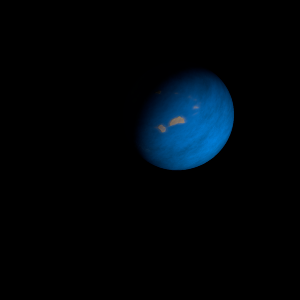|
|
Space Astro
|
Info for exoplanet "Apushar Te"
| Scientific (actual) data |
|---|
| Name | Kepler-194 c |
| Planet status | Confirmed |
| Radius | 0.231 |
| Orbital period | 17.308 |
| Semi major axis | 0.131 |
| Discovered | 2014 |
| Updated | 2021-02-05 |
| Tconj | 2455010 |
| Impact parameter | 0.08 |
| Publication | Announced on a website |
| Detection type | Primary Transit |
| Alternate names | 2MASS J19275314+4751510 c, K00597.01, KIC 10600261 c, KOI-597 c, KOI-597.01, WISE J192753.14+475150.6 c |
| Star name | Kepler-194 |
| Right ascension | 291.97° |
| Declination | 47.86° |
| Mag j | 13.78 |
| Mag h | 13.45 |
| Mag k | 13.512 |
| Star distance | 1133.48 |
| Star metallicity | -0.298 |
| Star radius | 1.02 |
| Star temperature | 6089 |
| Star alternate names | 2MASS J19275314+4751510, KIC 10600261, KOI-597, WISE J192753.14+475150.6 |
| Wikipedia article | Kepler-194 c |
Back
| |
| Fictional info (?) |
|---|
| Suggested name | Apushar Te |
| Planet type | Terrestrial |
| The volume of water detected has been estimated to be equivalent to the volume of water in Earth's oceans.
Surface said to have small and ultra advanced aliens called the "Neculo-garet". They survive by devouring plants. Neculo-garet are related to Nusste Cu but with 7 tentacles and vary in size from 40 to 40 cm. The Neculo-garet are able to survive temperatures from 120 to 200°C and also drought which is common near the poles. |
| Estimated population | 2500000000 |
| Atmosphere | Carbon dioxide | 97% |
| Oxygen | 2.1% |
| Methane | 0.4% |
| Water | 1.1E-5% |
| Atmospheric pressure | 0.001 bar |
 |
| Moon | Bemar Daph | Huge slightly egg-shaped ice moon |
| Arkivi | Large slightly egg-shaped oceanic moon |
| Pacylte The | Small almost round oceanic asteroid |
| Mederok Thone | Small round oceanic moon |
| Maslao Silelaris | Medium-sized potato shaped oceanic moon |
| Lyppocal | Medium-sized round rocky moon |
| Setebauti | Small slightly egg-shaped crater-filled asteroid |
| Kopsauq Pal | Small slightly egg-shaped gaseous moon |
| Paathedys | Small slightly egg-shaped rocky comet |
| Forn | Huge round rocky moon |
| Mosron | Large almost round rocky moon |
| Sirhea | Small almost round gaseous moon |
| Fenlis | Huge almost round crater-filled planetoid |
| Karax | Very small round oceanic planetoid |
| Onepor Hionn'thea | Huge slightly egg-shaped crater-filled asteroid |
| Bekin-gete Ede | Huge slightly egg-shaped oceanic asteroid |
| Raqganomia | Medium-sized slightly egg-shaped crater-filled moon |
| Thea | Very small round ice comet |
| Gaiaka | Very small irregular ice moon |
| Anotheus Thi | Large almost round rocky moon |
| Laris Tohi | Very small slightly egg-shaped crater-filled comet |
| Hermedeia'mos | Very small irregular rocky asteroid |
| Kesurdelia | Small round rocky moon |
| Atneso'gir | Large slightly egg-shaped crater-filled asteroid |
| Theus-car | Huge potato shaped ice asteroid |
| Nareury-ly | Large almost round crater-filled planetoid |
| Google search for Apushar te |
|
Website by Joachim Michaelis
|
|
|
|